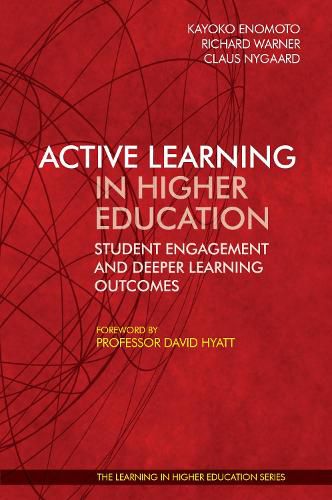Readings Newsletter
Become a Readings Member to make your shopping experience even easier.
Sign in or sign up for free!
You’re not far away from qualifying for FREE standard shipping within Australia
You’ve qualified for FREE standard shipping within Australia
The cart is loading…






This title is printed to order. This book may have been self-published. If so, we cannot guarantee the quality of the content. In the main most books will have gone through the editing process however some may not. We therefore suggest that you be aware of this before ordering this book. If in doubt check either the author or publisher’s details as we are unable to accept any returns unless they are faulty. Please contact us if you have any questions.
This is the latest volume in the Learning in Higher Education series. Active Learning has at least two major benefits: 1) it engages students in their learning, and 2) it enhances their deeper learning outcomes. In this book, authors from universities in Australia, Canada, Italy, New Zealand, Romania, Turkey, the UK and the USA show how they have used active learning to engage their students and improve their deeper learning outcomes. Reading the book, you will gain insight into how the authors designed and carried out their teaching, using one of these eleven active learning methods:
authentic project-based learning; case-based learning; experience-based learning; flipped and peer learning; inquiry-based learning; learning space design; project-based learning; research-based learning; students as partners framework; technology-enhanced learning; and virtual exchange co-design.
The deeper learning outcomes documented by surveying or interviewing students include: a sense of belonging for improving retention; development of graduate attributes; digital pedagogy and professional skills; engaged and enhanced learning experiences; enhanced well-being; graduate employability; interpersonal and leadership skills; reflective practitioners; research communication competencies; and retention and employability. All the chapters in the book are underpinned by contemporary learning theories and methodologies on active learning. Yet, they are written in a direct and accessible language to inspire the reader to engage in teaching practices that enhance active learning in higher education.
$9.00 standard shipping within Australia
FREE standard shipping within Australia for orders over $100.00
Express & International shipping calculated at checkout
This title is printed to order. This book may have been self-published. If so, we cannot guarantee the quality of the content. In the main most books will have gone through the editing process however some may not. We therefore suggest that you be aware of this before ordering this book. If in doubt check either the author or publisher’s details as we are unable to accept any returns unless they are faulty. Please contact us if you have any questions.
This is the latest volume in the Learning in Higher Education series. Active Learning has at least two major benefits: 1) it engages students in their learning, and 2) it enhances their deeper learning outcomes. In this book, authors from universities in Australia, Canada, Italy, New Zealand, Romania, Turkey, the UK and the USA show how they have used active learning to engage their students and improve their deeper learning outcomes. Reading the book, you will gain insight into how the authors designed and carried out their teaching, using one of these eleven active learning methods:
authentic project-based learning; case-based learning; experience-based learning; flipped and peer learning; inquiry-based learning; learning space design; project-based learning; research-based learning; students as partners framework; technology-enhanced learning; and virtual exchange co-design.
The deeper learning outcomes documented by surveying or interviewing students include: a sense of belonging for improving retention; development of graduate attributes; digital pedagogy and professional skills; engaged and enhanced learning experiences; enhanced well-being; graduate employability; interpersonal and leadership skills; reflective practitioners; research communication competencies; and retention and employability. All the chapters in the book are underpinned by contemporary learning theories and methodologies on active learning. Yet, they are written in a direct and accessible language to inspire the reader to engage in teaching practices that enhance active learning in higher education.